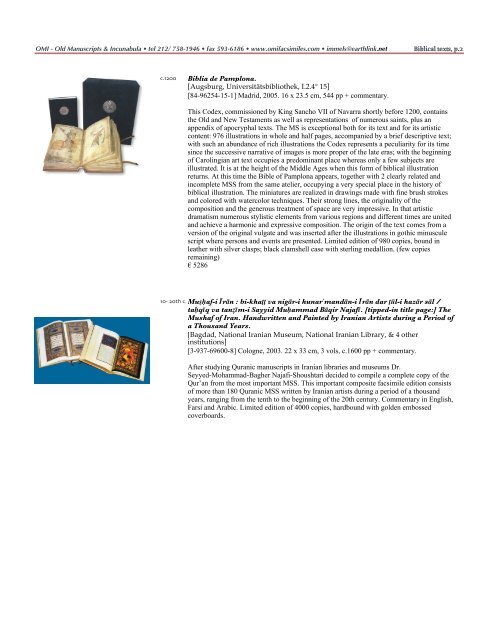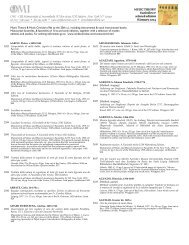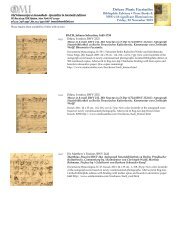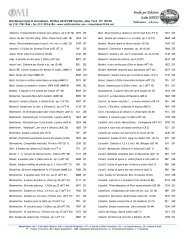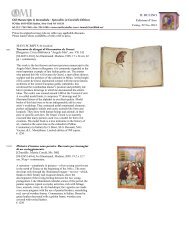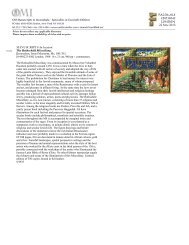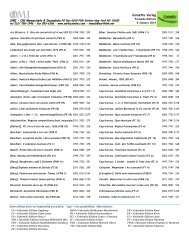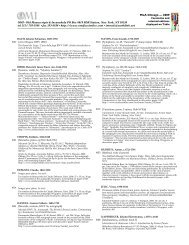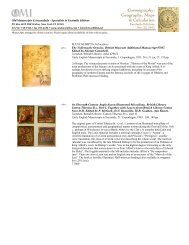Bibles & sacred texts - facsimiles - Omi
Bibles & sacred texts - facsimiles - Omi
Bibles & sacred texts - facsimiles - Omi
You also want an ePaper? Increase the reach of your titles
YUMPU automatically turns print PDFs into web optimized ePapers that Google loves.
OMI - Old Manuscripts & Incunabula • tel 212/ 758-1946 • fax 593-6186 • www.omi<strong>facsimiles</strong>.com • immels@earthlink.net Biblical <strong>texts</strong>, p.2<br />
c.1200 Biblia de Pamplona.<br />
[Augsburg, Universitätsbibliothek, I.2.4° 15]<br />
[84-96254-15-1] Madrid, 2005. 16 x 23.5 cm, 544 pp + commentary.<br />
This Codex, commissioned by King Sancho VII of Navarra shortly before 1200, contains<br />
the Old and New Testaments as well as representations of numerous saints, plus an<br />
appendix of apocryphal <strong>texts</strong>. The MS is exceptional both for its text and for its artistic<br />
content: 976 illustrations in whole and half pages, accompanied by a brief descriptive text;<br />
with such an abundance of rich illustrations the Codex represents a peculiarity for its time<br />
since the successive narrative of images is more proper of the late eras; with the beginning<br />
of Carolingian art text occupies a predominant place whereas only a few subjects are<br />
illustrated. It is at the height of the Middle Ages when this form of biblical illustration<br />
returns. At this time the Bible of Pamplona appears, together with 2 clearly related and<br />
incomplete MSS from the same atelier, occupying a very special place in the history of<br />
biblical illustration. The miniatures are realized in drawings made with fine brush strokes<br />
and colored with watercolor techniques. Their strong lines, the originality of the<br />
composition and the generous treatment of space are very impressive. In that artistic<br />
dramatism numerous stylistic elements from various regions and different times are united<br />
and achieve a harmonic and expressive composition. The origin of the text comes from a<br />
version of the original vulgate and was inserted after the illustrations in gothic minuscule<br />
script where persons and events are presented. Limited edition of 980 copies, bound in<br />
leather with silver clasps; black clamshell case with sterling medallion. (few copies<br />
remaining)<br />
€ 5286<br />
10- 20th c. Muṣḥaf-i Īrān : bi-khaṭṭ va nigār-i hunarʹ′mandān-i Īrān dar ṭūl-i hazār sāl /<br />
taḥqīq va tanẓīm-i Sayyid Muḥammad Bāqir Najafī. [tipped-in title page:] The<br />
Mushaf of Iran. Handwritten and Painted by Iranian Artists during a Period of<br />
a Thousand Years.<br />
[Bagdad, National Iranian Museum, National Iranian Library, & 4 other<br />
institutions]<br />
[3-937-69600-8] Cologne, 2003. 22 x 33 cm, 3 vols, c.1600 pp + commentary.<br />
After studying Quranic manuscripts in Iranian libraries and museums Dr.<br />
Seyyed-Mohammad-Bagher Najafi-Shoushtari decided to compile a complete copy of the<br />
Qur’an from the most important MSS. This important composite facsimile edition consists<br />
of more than 180 Quranic MSS written by Iranian artists during a period of a thousand<br />
years, ranging from the tenth to the beginning of the 20th century. Commentary in English,<br />
Farsi and Arabic. Limited edition of 4000 copies, hardbound with golden embossed<br />
coverboards.


